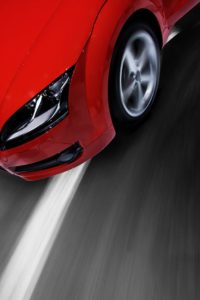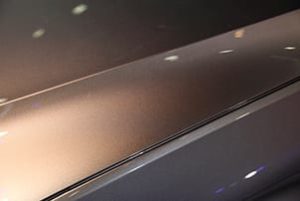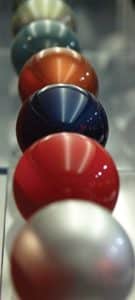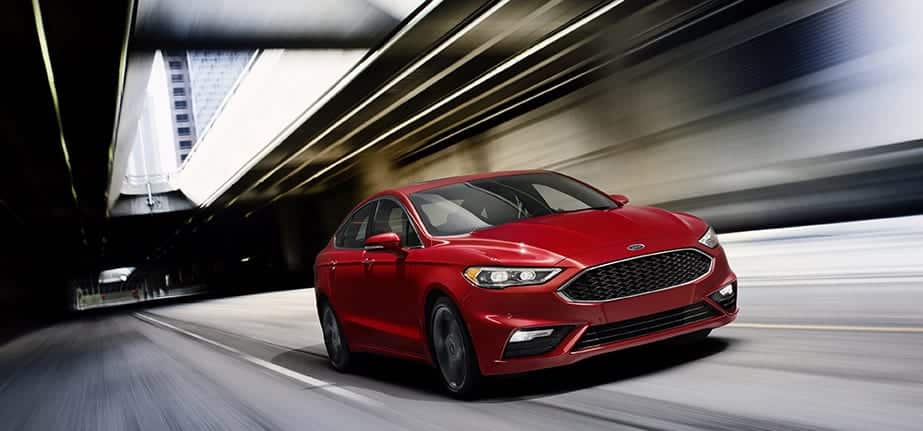By Cynthia Challener, CoatingsTech Contributing Writer
Regardless of the end-use application, special effect pigments provide a differentiated appearance. That is certainly true in the automotive industry, where they are used in coatings applied to both the interior and exterior of vehicles. Shifts in customer color and appearance preferences drive the use and development of effect pigments, as do developments in coatings technology and application processes. High sparkle finishes and intensely chromatic colors on car bodies and mirror-like finishes on interior components are increasing in popularity and driving the use of glass flakes, colored aluminums, and aluminum pigments with a much finer particle size. Pigments also need to provide the same appearance in coatings with thinner and/or fewer layers while exhibiting increased durability.
Creating a Unique Look
Coatings formulators work directly with pigment suppliers to develop and commercialize new specialty effect pigments to generate exciting color spaces that accentuate the bodylines of new vehicles. Effect pigments are the fastest growing segment of the high performance pigment market, and in 2015 were present in 70% and 65% of automotive colors for new builds in the Americas and Europe, respectively, according to Jane Harrington, manager of color styling with PPG Automotive OEM Coatings. “While neutral colors such as white, black, and silvers still dominate most of the automotive color palette, deep, rich, highly chromatic blues, greens, oranges, and reds have begun to find their place in the automotive world as well,” says Jason Kuhla, manager of technical service & product application with Silberline Manufacturing. “Special effect pigments that provide brilliance and ‘pop’ can help to create a look that stands out among the sea of color monotony, and appeal to those consumers who wish to stand apart from the crowd,” he adds. Allen Brown, advanced development and mastering manager in the Color and Material Design group of Ford Motor Company, agrees that while there will always be niche colors for special applications, overall there seems to be a balancing of colors to round out a complete selection, with a shift away from achromatic colors to a more sophisticated, balanced palette. For some applications, designers are seeking to create a value-added appearance by increasing the brilliance and reflectivity of metallic finishes while maintaining a smooth, non-sparkling appearance, according to Michael T. Venturini, global marketing manager, Coatings, Sun Chemical Performance Pigments.
Effect pigments are the fastest growing segment
of the high performance pigment market, and in 2015
were present in 70% and 65% of automotive colors
for new builds in the Americas and Europe . . . .
To achieve the desired appearance, most pigment flakes must be oriented in a specific manner within the coating. Their particle size also impacts the way they interact with light; larger particles provide more sparkle and iridescence, but the dimensions are limited to avoid impacts on gloss and other appearance properties. The industry is pushing the limits in this area, according to Paul Czornij, technical manager with the Color Excellence Group of BASF Coatings, and is seeking as much coarseness as the color can allow yet still providing a smooth and glossy look. The rheology of effect pigments, particularly in high solids, solvent-based systems, also influences their final appearance properties. On the other hand, there is a desire for smoother glass-like finishes, which has led to greater use of finer particle sizes to help deliver a quality liquid appearance in many colors, according to Brown. However, smoother finishes that give strong travel (bright face and dark side-tone) are difficult to achieve with electrostatic bell application (preferred for its greater transfer efficiency), which tends to make flakes stand up and give a more granular appearance, according to John Book, product line manager with Viavi. “Smaller particle sizes and size distributions also have a negative impact on color capability and metallic orientation, so such advances are far from simple,” asserts Frank Maimone, manager of pigment and color technology for the Color Development group of PPG Automotive OEM Coatings.
The shape of the vehicle has a significant impact on which effect pigments are used. For instance, fine/bright effect pigments that give coatings brightness with higher travel are preferred for vehicles that have a more interesting, free-flowing form, while for trucks, which are more slab-sided, coatings with more sparkle are frequently used, according to Jerry Koenigsmark,* who was manager of technical color design for PPG Automotive Coatings in North America. “For many of the new car designs targeting a younger consumer base, there is a push towards highly chromatic colors that employ colored aluminum pigments, mica pigments, glass flakes, and interference pigments,” says Kuhla. He also notes a shift in the wheel coatings market, where black is becoming more popular at the expense of traditional silvers.
 For car interior trim parts, chrome-like coatings are used to create a value-added look and add haptic properties to simple plastic and other components. Auto parts and accessories (APA) also tend to be dominated by silvers, and many of these coatings contain pigments manufactured using physical vapor deposition (PVD) processes. In addition, many interior coatings are intended to provide attractive haptic properties. Because they are often single-layer systems, the effect pigments must have high resistance to body oils, perspiration, lotions, cosmetics, and other chemicals, according to Jörg Krames, vice president for global key account management with Eckart. He also notes, in these applications, liquid coatings compete with powder coatings and alternative technologies such as in-mold decoration with foils.
For car interior trim parts, chrome-like coatings are used to create a value-added look and add haptic properties to simple plastic and other components. Auto parts and accessories (APA) also tend to be dominated by silvers, and many of these coatings contain pigments manufactured using physical vapor deposition (PVD) processes. In addition, many interior coatings are intended to provide attractive haptic properties. Because they are often single-layer systems, the effect pigments must have high resistance to body oils, perspiration, lotions, cosmetics, and other chemicals, according to Jörg Krames, vice president for global key account management with Eckart. He also notes, in these applications, liquid coatings compete with powder coatings and alternative technologies such as in-mold decoration with foils.
Finding Functional and Sustainable Solutions
Numerous other factors influence the choice of effect coatings beyond the appearance a designer wishes to create. In addition to provoking an emotional response in car buyers, effect pigments are often expected to serve multiple additional functions, according to Krames. The functional performance will be dictated by the type of coating and coating application systems. For external coatings, the compact application processes (primerless coating systems, three-coat/one-bake, integrated processes) widely used today on exterior car bodies involve the application of only a basecoat and topcoat over the e-coat. “Effect pigments in these systems must provide hiding power and exhibit high chemical-, moisture-, and UV-resistance properties in order to protect the e-coat,” he says. In addition, coating formulations now have higher pigment concentrations in smaller volumes, and the coating layers are either thinner or the flash times are eliminated. “Both scenarios have a negative impact on coating appearance and require extensive reformulation of coatings to meet end-use expectations,” notes Thomas A. Cook, global manager for color and process technologies with PPG Automotive OEM Coatings.
The trend towards thinner coatings has driven the development of new low-aspect-ratio effect pigment particles like colored, thin silver-dollar aluminum pigments that deliver brilliant metallic luster in high-chroma hues with good hiding and gloss. Generally, the use of smaller particle sizes will provide a smoother appearance with good gloss. However, to achieve the most chromatic colored effects and good flop behavior, manufacturers must consistently deliver highly optimized particle size distributions, comments Mike Crosby, market segment manager for BASF’s Global Automotive/OEM Pigments Business Unit. New lightweight substrates have surface-roughness and adhesion issues that also require coating reformulation, according to Bill Eibon, director of technology acquisitions for PPG Automotive OEM Coatings. On a positive note, Brown points out that ultra-smooth primers have helped to achieve a better glass-like appearance by creating a smoother base on which to paint.
 Such integrated processes are just one response by the automotive industry to improve sustainability, reduce the use of hazardous materials and its carbon footprint, and meet increasing governmental regulatory requirements—all while ensuring outstanding value and consumer satisfaction, according to Czornij. “These imperatives are driving innovation and change, and even as formulations and applications change, effect pigments must continue to afford durable coatings that are aesthetically pleasing and in alignment with trends in color popularity,” he asserts. The ongoing switch to water-based coatings is another key driver of effect pigment development. The goal has been to achieve highly brilliant products with identical optical properties as those of solvent-based and nontreated pigments, according to Mark Stoll, global head of marketing & technical service with Eckart. Although stability issues with aluminum pigments in waterborne formulations have, in general, been resolved with silica encapsulation technology, Venturini notes that the increasing adoption of waterborne coatings continues to drive pigment innovation as producers seek more efficient ways to better stabilize their pigments and make them easier to use.
Such integrated processes are just one response by the automotive industry to improve sustainability, reduce the use of hazardous materials and its carbon footprint, and meet increasing governmental regulatory requirements—all while ensuring outstanding value and consumer satisfaction, according to Czornij. “These imperatives are driving innovation and change, and even as formulations and applications change, effect pigments must continue to afford durable coatings that are aesthetically pleasing and in alignment with trends in color popularity,” he asserts. The ongoing switch to water-based coatings is another key driver of effect pigment development. The goal has been to achieve highly brilliant products with identical optical properties as those of solvent-based and nontreated pigments, according to Mark Stoll, global head of marketing & technical service with Eckart. Although stability issues with aluminum pigments in waterborne formulations have, in general, been resolved with silica encapsulation technology, Venturini notes that the increasing adoption of waterborne coatings continues to drive pigment innovation as producers seek more efficient ways to better stabilize their pigments and make them easier to use.
Additional important trends noted by Book include the incorporation of effect pigments in the clearcoat, where historically they have only been used in the basecoat. This application is commonly referred to as tinted clearcoats. “Increased color saturation and depth are achieved when effect pigments are present in the basecoat and finely milled organic pigments are added to the clearcoat,” he says. The effect is enhanced when new nanoscale pigments with increased dispersion saturation are used in the tinted clearcoats, according to Brown. “These systems have allowed us to achieve color spaces not obtainable in the past, such as our Ruby Red on the Ford Fusion and Burgundy Velvet on the Lincoln MKZ. Both colors were created using ANDARO® effect pigments from PPG. However, as with other recent development, these finishes are not easily applied or repaired, and OEMs are looking for alternative two-coat solutions that can replicate this look,” according to Book. PPG color experts would like to see durable dye-like systems with ultra-high transparency for use in both solvent-based and water-based coatings, as well as thinner flakes to minimize the number of clearcoat layers needed to bury the finish. Book does note that new colored aluminum pigments can create a tinted clearcoat appearance that is much easier to apply and repair.
Advances in Pigment Technology
In addition to the development of effect pigments already mentioned, pigment manufacturers have responded to changing coatings formulation and application trends and technologies with a variety of technology advances of their own. Dieter Marquardt, manager of color matching, Europe, with PPG Automotive OEM Coatings notes two key advances. The first is process improvements in the manufacturing of synthetic micas that make them more affordable and will drive a shift away from natural micas and lead to the development of more chromatic colors and improved appearance. The second is new processes to generate colored aluminums based on inorganic layers and brighter aluminum feedstocks that offer stylists higher chroma and color saturation. Thin, silver-dollar colored aluminum pigments are producing new and attractive color spaces with dramatic chroma and travel characteristics. Colored aluminum pigments also enable styling of rich, chromatic colors at a lower pigment loading than a combination of traditional silver aluminum silver dollars with absorption pigments. They can therefore deliver good hiding with excellent gloss, even in thin-film automotive coatings, according to Crosby. Meanwhile, the process of depositing different layering systems on pigment cores has driven the introduction of more dramatic effects such as better color travel and more sparkle, according to Gareth Hughes, director of Americas Technology for PPG Automotive Refinish. “The use of multiple layer stacks to optimize light travel and interference in pearlescent pigments is a major contributor to the new high-impact colors you see today,” Crosby agrees.
 Kuhla sums it up best: “High chroma, multilayer effect pigments, newer shades of colored aluminum flake, and glass flake pigments have given color formulators the tools they need to achieve head-turning color shades that excite consumers and inspire pigment research to dig even deeper into what variations of these new technologies can yield. From the high-sparkle glitz of glass flakes to the eye-appealing, high opacity of colored aluminums, recent developments are giving formulators the ability to make colors that dazzle.”
Kuhla sums it up best: “High chroma, multilayer effect pigments, newer shades of colored aluminum flake, and glass flake pigments have given color formulators the tools they need to achieve head-turning color shades that excite consumers and inspire pigment research to dig even deeper into what variations of these new technologies can yield. From the high-sparkle glitz of glass flakes to the eye-appealing, high opacity of colored aluminums, recent developments are giving formulators the ability to make colors that dazzle.”
It should also be noted that for many of the challenges facing automotive coating formulators working with effect pigments, effective solutions are often achieved with the use of additives. “At Eckart, we have found it hugely beneficial to have direct access to additive technologies through Altana’s BYK division. Cooperative development of effect pigments and additives makes it possible to develop higher-performance products,” Krames remarks.
There are limitations of effect technology that pigment manufacturers, coating formulators, and car makers continue to work to address. Many are related to the coating application process. “We are challenged by the effect on flake orientation from bell application, and there is a need for improvement in aluminum travel through equipment, formulation, and flake technology,” says Maimone. There is also a need for an alternative to vacuum metalized aluminum pigments that can produce a liquid metal effect or highly brilliant mirror-like finish using conventional application technology, according to Venturini. “Even with vacuum metalized pigments, specific low-solids paint technology and a highly specialized, skilled application process must be used to achieve the desired appearance,” he adds. As a result, the number and types of end-use applications are limited—chrome-like wheel finishes are one example. “Simplification of the process would open the door to a wider range of applications,” asserts Venturini. Ford would like to see one-layer specialty “liquid” and anodized coatings that meet all specifications without the need for a clearcoat, according to Brown.
High chroma, multilayer effect pigments, newer shades of colored aluminum flake, and glass flake pigments have given color formulators the tools they need to achieve head-turning color shades that excite consumers and inspire pigment research to dig even deeper into what variations of these new technologies can yield.
Mike Jones, paint material engineer with Ford’s Vehicle Operations unit, notes that, in general, coatings with effect pigments can be more difficult to apply than coatings with traditional pigments, but the process is manageable. Color-shifting pigments pose the greatest challenge. “The color changes at different angles, and it can be difficult to achieve the same type of changes on all components of a vehicle, largely due to vehicle geometry and the use of different application equipment and/or process conditions at the different component suppliers,” he explains. There is, in fact, a general need to be more consistent with application processes for all coatings that contain effect pigments, according to Jones. “These coatings are not as forgiving as paints containing traditional pigments,” he says. Jones has also seen issues with the application of coatings containing aluminum pigments created using PVD. Krames adds that the ability to combine PVD with electrostatic spray application is a major focus of research for the automotive industry.
There are, in fact, a number of fascinating new effect technologies under development with potential for use in the automotive industry in the distant future. Pigments that have switchable functionality or that incorporate photocatalytic TiO2 are just two of the innovations Eckart is investigating. Eckart is also developing effect pigments for improved heat insulation and better corrosion protection, as well as pigments that have multiple functionality. Viavi, meanwhile, is developing a new pigment effect that draws inspiration from the natural surface of a moth’s eye. This very fine structure creates a blue-green glow when viewed in retro-reflection, according to Book.
Ford is paying close attention to potential legislation related to infrared (IR) requirements in California and a few other states. “The California Air Resource Board (CARB) rules may require specification of the amount of IR energy absorbed by a vehicle in order to help regulate the temperature in the interior and thus reduce the size of the air-conditioning unit and increase mileage,” Brown explains. There is also interest in the use of effect pigments in marketing strategies. Book raises the concept of paid colors. “Premium colors have been available in the luxury segment for some time. OEM’s are also now more frequently offering modestly priced special option colors on economy cars. As a result, it is becoming an increasingly difficult challenge to maintain an appearance difference for luxury cars, leading to more innovation in pigment and coating technologies,” he notes. Brown is also interested in specialty pigments that are tailored to represent a specific brand.
Whatever the driving forces, continued development of interesting effect pigment technologies can be expected going forward. “PPG receives a lot of unique special-effects requests from young automotive designers, so I think there will be some exciting things happening in the future in exterior auto paints, according to Koenigsmark.”*
*Jerry Koenigsmark, who was Manager of Technical Color Design for PPG Automotive OEM Coatings in North America, passed away in December 2015 after a brief battle with pancreatic cancer. He had worked for PPG for over 30 years. Jerry’s color expertise, creativity and passion for cars will be missed by the global automotive industry, and his impact on automotive color design will live on in future model years.
